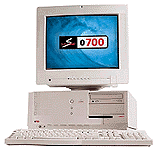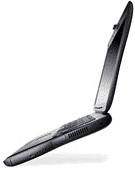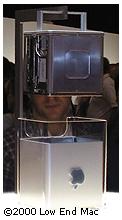Mac Musings
When to Buy New
Daniel Knight - August 21, 2000 -
I've had a few new computers over the years - a just
discontinued Mac Plus, a
recently introduced Centris 610,
a close-out PowerBook 150 (my wife's
Mac for several years),  and a
fire-sale SuperMac J700 (when
Umax got out of the clone business). None were even close to
cutting edge at the time. The Centris 610 was the closest; its 20
MHz 68LC040 outperformed the IIci I used at work, but didn't hold a
candle to the Quadra 800 with its
full fledged 68040 running at 33 MHz.
and a
fire-sale SuperMac J700 (when
Umax got out of the clone business). None were even close to
cutting edge at the time. The Centris 610 was the closest; its 20
MHz 68LC040 outperformed the IIci I used at work, but didn't hold a
candle to the Quadra 800 with its
full fledged 68040 running at 33 MHz.
The rest of my Macs have been acquired used or new-but-stripped (a SuperMac S900 and SuperMac C600).
I've comfortably maintained a "low end" existence at least a couple steps behind the bleeding edge. And even in my retail days, I tended to push such systems for customers who didn't have high end needs such as graphic design or CAD.
Building Up Your Mac
One nice thing about Macs is how easy is has been to build them into better computers. With the Plus, you could strap on all sorts of SCSI devices, boost memory to 4 MB, and even drop in accelerators or video cards. My Centris 610 had two hard drive transplants and several upgrades while I used it. My wife's PB 150 had a memory upgrade and a modem added.
My current workhorse, the SuperMac S900, is pretty packed. I've replaced the stock Twin Turbo video card with an Ultimate Rez, added Umax's E100 card for fast/wide SCSI and 100bps ethernet, stuck in a USB card so I can use and test USB peripherals, plugged in a TurboMax IDE card and 15 GB IBM hard drive, upgraded the CPU card twice, and, just for kicks, even added an ixMicro TV card. Good thing it's a six-slot machine.
But it can also be a frustrating pain in the user experience. I started using my J700 with Mac OS 7.6.1, moved to 8.1, then moved all the components into the bare-board S900. Then came Mac OS 8.5.1 and 8.6. (I avoided 7.6, 8.0, and 8.5, all of which were a bit troublesome. I try to avoid a new OS until the first round of patches has been released.)
I'm running Mac OS 9 on my J700 and have it installed on a partition of my S900, too. Thanks to Copy Agent, I'm only one application shy of being able to move to OS 9 (I consider QuicKeys crucial, but it isn't cheap).
But there are problems out there. Will my TurboMax card work with OS 9 (it seems to so far)? Why won't the E100 card work? I need that to run backup to my VXA tape drive. Will the ixTV software work with OS 9? (Okay, I can probably live without that.)
I'll probably leave one of these SuperMacs running Mac OS 8.6 for backup, video input, and so I don't have to worry about software problems with OS 9. In other words, my production machine will remain OS 8.6 as long as possible.
But I've basically got a very cobbled together computer. I can't boot from the stock CD-ROM by holding down the C key. The video card needs drivers that don't come with the Mac OS. The TurboMax card may or may not work with the next OS update. The S900 wasn't even designed to work with IDE drives for that matter.
Lately the computer has grown less and less stable. It could be the myriad of programs, control panels, and extensions installed. It could be the plethora of third-party hardware. It could be the games, the power supply, or the phase of the moon.
Recently I've been running Norton Utilities and/or Alsoft Disk Warrior almost daily. It's growing tiresome. I finally ended up reinstalling the whole OS, although it's a task I'd rather not undertake. (BTW, if you ever have to do that, use Clean-Install Assistant. It will help preserve your sanity.)
Buying New
At this point, I'd just as soon ditch the whole thing and buy a whole new computer. That's how tiresome troubleshooting can become. Or maybe it's just that I do too much troubleshooting between 80-90 Macs at work, a huge mixed 10Best-T and 100-Base-T ethernet network, occassional ISDN troubles, cable modem nightmares at home, and so on.
At this point, I'd rather just come home to a computer that works. My cobbled together circa 1996 computer feels like a car that's been dependable but has spent a bit too much time with the mechanic lately.
So what I'd really like to do is replace it. That's not in the budget, but let's pretend it is.
There are three choices, since I rule out the iBook and iMac based on screen size.
The  PowerBook
PowerBook
Having toted my wife's WallStreet PowerBook around Macworld Expo, I would love one of the new Pismo PowerBooks. It's nearly two pounds lighter, has a larger screen (14.1" 1024 x 768 vs. 12.1" 800 x 600), and takes AirPort. Speed isn't an issue: past 300 MHz or so, any Mac is fast enough for me. I'd want lots of memory so I can set up a ramBunctious RAM disk to store my Web pages - you wouldn't believe how fast BBEdit Lite can zip through thousands of pages on a RAM disk, updating links to sites that have new URLs!
To do it right, I'd want to add 256 MB to the stock 64 MB, bringing the $2,500 PowerBook to about $2,750 (see ramseeker for prices). The only drawback is that I'm spoiled with a 1280 x 1024 21" screen at work and get by with a 1152 x 870 19" one at home. After that, 1024 x 768 feels cramped.
On the other hand, if Apple had a megascreen PowerBook, that would be my top choice.
The Power Mac G4
I'm using a G4/400 (Yikes!) at work, one of two my employer owns. The rest of our G4s are 400 MHz Sawtooths, the model that supports AirPort and has a faster memory bus. They're all very nice, very fast computers.
I could live with a G4/400, especially at some of the prices I've seen lately (DealMac mentioned a $1,350 price last week). According to ramseeker, I could add one 256 MB DIMM for as little as $250, giving me a very powerful computer for about $1,600.
The G4 has its own elegance, but it wouldn't last. The first thing I'd do is put in a SCSI card for my old Zip drive and my new VXA tape drive. And suddenly you've got all those ugly boxes again.
The  Cube
Cube
I have to admit I was blown away when I first saw the Cube at Macworld Expo. I'd missed the keynote, but saw it on the floor. The photo at right shows an "exploded" Cube; the display was constantly surrounded by people studying the incredibly compact design.
The Cube is very attractive - and even more powerful than the G4/400 I'm used to. It doesn't have the PCI slots or extra drive bays of the Power Mac G4; it doesn't have to.
I'm a legacy guy. I like my SCSI peripherals. But I've always got my SuperMacs to run network backup.
The Cube is seductive, like the Ruby iMac. You see it; you want it. The question is, does it make sense?
Conclusion
Over the past week, I've come to admit that I could live without SCSI and PCI slots if the computer already had everything you needed. I believe the Cube, the PowerBook, and the Power Mac G4 each come close. Very close.
The PowerBook couldn't replace my desktop. I simply need the large screen so I can have a browser window and HTML window open next to each other. But given a larger screen, I could make a PowerBook my production machine. I'd need to add a Zip drive, whether USB, FireWire (do they make one yet?), or expansion bay.
The Power Mac G4 could replace my desktop. I can even get a build-to-order unit with a Zip drive and SCSI card, having Apple pull the unnecessary modem and give me a small credit for it. It's big, it's not too quiet, it's not bad looking, and it offers all the power I really need.
The Cube could replace my desktop. It's gorgeous, compact, quiet, and wicked fast. Again, I'd need to add a Zip drive, but that's not a big deal.
Bang for the buck, the G4/400 is the hands-down winner, but if Apple offered a 400 MHz Cube for the same price, that would be my choice.
Still, at this point I would have to consider any desktop computer a stop-gap solution until my dream PowerBook with a 1280 x 1024 screen becomes available. Once that ships, I'm ready to kiss desktops good-bye.
For the record, I'd buy the slowest version available. I just hate paying a premium to be on the bleeding edge.
Join us on Facebook, follow us on Twitter or Google+, or subscribe to our RSS news feed
Dan Knight has been using Macs since 1986, sold Macs for several years, supported them for many more years, and has been publishing Low End Mac since April 1997. If you find Dan's articles helpful, please consider making a donation to his tip jar.
Links for the Day
- Mac of the Day: PowerBook 2300, introduced 1995.08.28. The only Duo equipped with a PowerPC processsor run at 100 MHz.
- Support Low End Mac